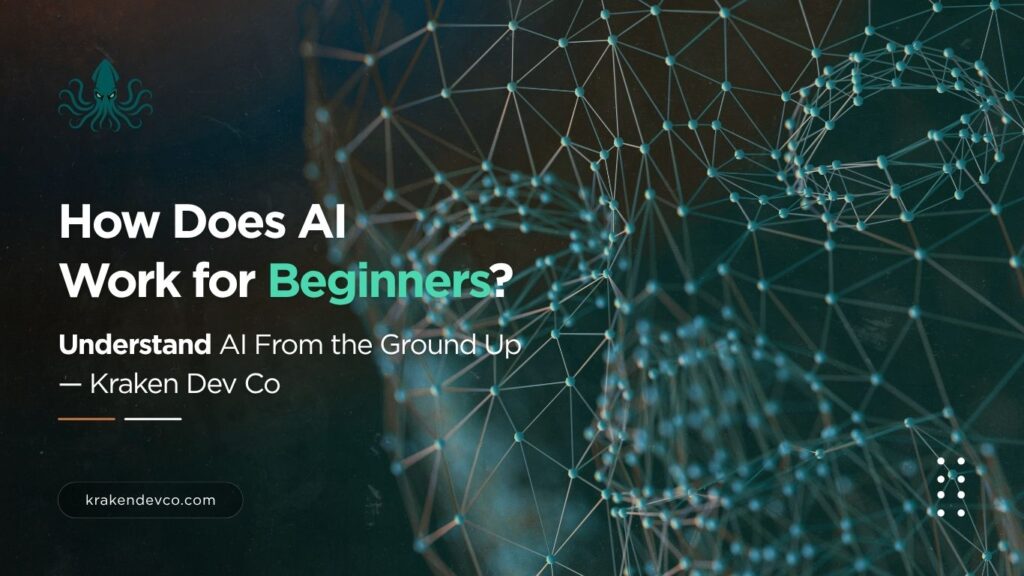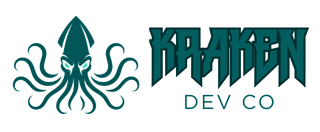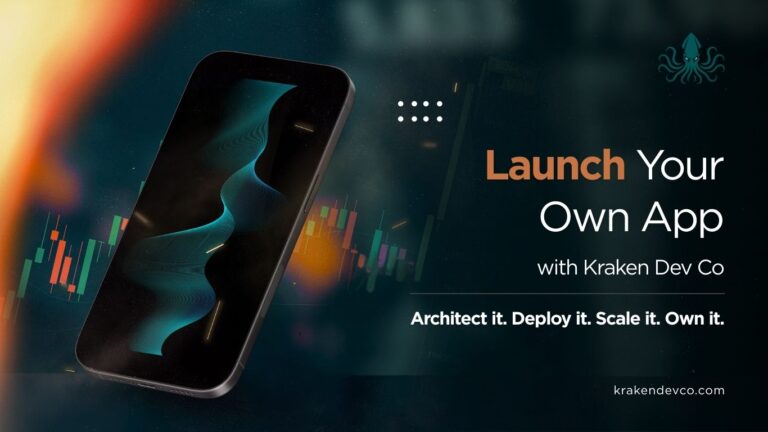
Understand AI From the Ground Up — Kraken Dev Co
Artificial Intelligence isn’t mystical. It’s not sentient. It’s engineered. And at Kraken Dev Co, we architect, audit, and deploy AI systems that serve actual business objectives— not hype cycles.
If you’re a developer, founder, or enterprise decision-maker looking to demystify how AI works, this breakdown will clarify the moving parts — from neural networks and natural language processing to self-driving cars and responsible AI frameworks. This isn’t fluff. It’s how AI actually works.
What Is Artificial Intelligence?
Artificial Intelligence (AI) refers to the engineering of systems that simulate human cognitive processes like perception, decision-making, and learning. But machines don’t “think.” They analyse inputs, extract patterns, and produce optimised outputs.
At Kraken Dev Co, we don’t build chatbots and call it AI. We work with AI systems that process Big Data, optimise pipelines, and integrate directly into secure infrastructure.
AI falls into three main categories:
- Narrow AI – Purpose-built systems like virtual assistants or recommendation systems.
- General AI – Hypothetical machines with human-level general intelligence.
- Superintelligent AI – Purely theoretical; machines outperforming humans in all fields.
AI Architecture: Four System Types
Not all AI is built the same. There are four widely recognised classes of AI systems:
- Reactive Machines – Hardcoded logic with no memory. (e.g., Deep Blue)
- Limited Memory – Core to self-driving cars and autonomous systems, these models learn from historical data.
- Theory of Mind AI – A research concept. Not yet feasible.
- Self-Aware AI – Pure fiction. Doesn’t exist. Likely never will.
Machine Learning: The Core of AI Development
Machine Learning (ML) drives most modern AI. Instead of writing explicit rules, we train models using data.
Types of ML:
- Supervised Learning – Trained on labelled datasets.
- Unsupervised Learning – Detects patterns in unlabelled data.
- Reinforcement Learning – Trial-and-error learning, ideal for robotics and gaming.
- Deep Learning – Uses Deep Neural Networks (DNNs) to process speech, images, and text at scale.
We build ML pipelines that integrate securely with your stack — whether you’re deploying predictive analytics, AI apps, or Generative AI tools.
Neural Networks: Simulated Cognition
Neural networks simulate simplified neuron activity:
- Input layer – Ingests data.
- Hidden layers – Process features using Convolutional Neural Networks (for images) or Recurrent Neural Networks (for sequences).
- Output layer – Classifies or predicts.
Use cases:
- Speech recognition
- Image recognition
- Sentiment analysis
- Natural Language Processing (NLP)
NLP and Large Language Models
Natural Language Processing enables machines to parse human language. From Google Cloud AI to Hugging Face and GitHub Copilot, NLP is everywhere.
Modern Large Language Models (LLMs) — like the generative pre-trained transformer (GPT) series — are trained on massive datasets. They power:
- Chatbots
- Voice assistants
- Language understanding
- Document summarisation
- AI PCs for workplace automation
While LLMs don’t “understand” meaning, their probabilistic outputs make them highly functional.
AI Vision: Understanding Visual Data
Computer Vision systems allow machines to interpret visual inputs. They support:
- Object detection
- Image classification
- Image synthesis via Generative Adversarial Networks (GANs)
This powers everything from autonomous vehicles to AI-driven image generation in tools like Google Gemini and Amazon Lex.
Multimodal AI and Generative Systems
Modern AI is converging modalities — text, image, audio, and video. Tools like Massive Multitask Language Understanding (MMLU) signal a shift toward Artificial General Intelligence (AGI).
Multimodal systems enable:
- Input synthesis from text and images
- Context-aware interaction
- Cross-domain data integration
We deploy these systems through secure design practices and monitor them with incident management and supply chain security in mind.
AI Development Lifecycle
Every production-grade AI system follows a structured pipeline:
- Data Collection – Curated and compliant with Responsible AI protocols.
- Preprocessing – Normalisation, cleaning, formatting.
- Model Training – Using frameworks like Apache Spark, TensorFlow, or PyTorch.
- Inference Deployment – Applied to live environments.
- Continuous Feedback Loop – Monitored with tools like Visual Studio, Intel® Developer Zone, and OpenVINO™ Model Hub.
Our lifecycle design includes threat modelling, secure deployment, and technical debt management from day one.
Real-World AI Applications
Healthcare
- Genetic modelling
- AI-accelerated drug discovery
- Diagnostic image analysis
Finance
- Fraud detection
- Market prediction
- Asset performance monitoring
Transport
- Routing optimisation
- Autonomous robots
- Traffic analytics
Education
- Adaptive learning
- Automated grading
- Curriculum generation
Tools and Hardware Powering AI
Advanced AI requires serious compute. Kraken Dev Co works with:
- Intel Gaudi 3 AI accelerators
- Intel® Core™ Ultra processors
- Emerald Rapids and Ice Lake architecture
- Heterogeneous computing clusters
- Supercomputing infrastructure
We ensure hardware scalability through the Intel AI Developer Ecosystem, driving performance for high-load AI projects and AI factories.
AI Ethics, Regulation & The Human Layer
Unchecked AI is dangerous. We help clients navigate the evolving regulatory space:
- AI Act (EU)
- AI Continent Action Plan
- Data Act
- Sectoral safety legislation
We build AI with machine ethics frameworks and guardrails:
- Fairness audits
- Bias mitigation
- Explainability
- Robust privacy protocols
Artificial moral agents, robot rights, and even fictional cases like robot citizens must be addressed in context — ethically, legally, and architecturally.
AI Isn’t The Future. It’s Already In Play
You’re already using AI:
- Unlocking your phone with your face
- Voice search
- Spam filters
- Recommendation systems on Netflix
- Fraud alerts from your bank
Kraken Dev Co integrates these touchpoints into your stack with precision, scale, and accountability.
Learning Path: From Beginner to Deployment
Here’s a practical roadmap if you’re just starting:
Phase 1: Fundamentals
- Python, statistics, linear algebra
Phase 2: Core ML
- Scikit-learn, TensorFlow
- Data wrangling, modelling
Phase 3: Specialisation
- Pick your track: NLP, Computer Vision, Generative AI
- Build AI apps with real data
- Push to production with secure development workflows
Supplement with hands-on labs, user groups, and open-source tools like those from Hugging Face and Microsoft Cognitive Services.
Why Kraken Dev Co?
We don’t dabble in AI. We engineer it. Securely. Strategically. At scale.
From investor-backed AI startups to enterprise-grade AI systems, our track record includes:
- Model deployment with built-in observability
- Custom integration with cloud-native architectures
- Full-stack secure operation and maintenance
AI isn’t optional anymore. It’s infrastructure. And you need a partner that treats it that way.
Ready to understand, build, or scale AI the Kraken way?
Let’s talk.
Kraken Dev Co — Cutting through noise, shipping real AI.



